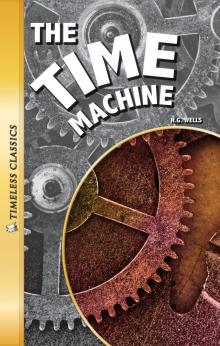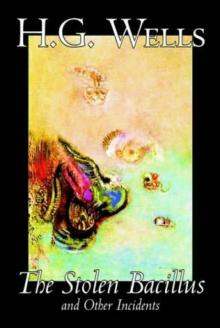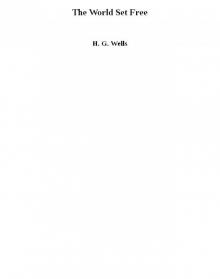- Home
- H. G. Wells
Time Machine and The Invisible Man (Barnes & Noble Classics Series) Page 3
Time Machine and The Invisible Man (Barnes & Noble Classics Series) Read online
Page 3
How could this unhealthy man (he suffered from tuberculosis and became seriously ill in 1887 and once again in 1893), totally untrained in “creative writing,” plying the journalist’s trade just to make ends meet, have both the imagination and the will to write—with no typewriter—so many words, compose so many tales? (True enough, he did have help: His second wife made clean copies of his manuscripts.) But the fact is Wells probably wrote much as he had spoken when he addressed his classes as a young teacher. Just as his lectures would have to be pitched to the level of his students, with a vocabulary they could readily fathom and a sentence structure that would elucidate rather than obfuscate the points he wanted to communicate, his fictions are exercises in clarity, and no less didactic than his lectures. In his satiric essay on Henry James (in his 1915 novel Boon), Wells castigated James for his notoriously convoluted style, comparing it to a hippopotamus trying to pick up a pea, and in a letter to James Joyce, whose work he admired but found overly complex, he stated simply, “I want language and statement as simple and clear as possible” (quoted in Michael Foot, The History of Mr. Wells, p. 215). Wells could never espouse the “art-for-art’s -sake” ideal: For him, art—all writing, in fact—had a single purpose, to communicate ideas and provoke change.
Wells was a self-made man: His literary talent earned him immortality. His social thought, expressed in countless fictions and essays, made him a kind of prophet. His views on history, as expressed in his Outline of History (1920), an international bestseller, fostered the very idea of universal history. But while his presence in the twenty-first century imagination remains huge thanks to works like The Time Machine and The Invisible Man, his presence in the social and political discourse of the new century is practically nonexistent.
The reason, simply put, is that Wells’s strength was also his weakness. The great nineteenth-century thinkers whose ideas are still current are those who created a school, a movement, a political party, something that transcended them as individuals. Karl Marx is more than a political philosopher toiling away in the academic wilderness. Sigmund Freud is more than a Viennese physician with newfangled ideas about the workings of the human mind. Both of these individuals gave rise to institutions larger than themselves. This Wells could never do, probably because like his own protagonists he was and would always remain a Romantic, an isolated voice demanding that others follow his ideas but unwilling to roll up his sleeves and dirty his hands in the practical application of his own concepts.
And the triumph and tragedy enacted in the two fictions under discussion here, The Time Machine and The Invisible Man, are parallel.
The narrative structure of The Time Machine reflects and enacts Wells’s lifelong dilemma. We have on the one hand the man of science who acts alone, the nameless Time Traveller, and on the other the man who writes for others, the sentimental Hillyer. Why Wells decided to leave his Time Traveller anonymous may reflect the various versions the story passed through, first in 1888, then in 1889, and again in 1892. There the Time Traveller has the allegoric name Dr. Moses Nebogipfel: Moses the Hebrew prophet who leads the Israelites out of Egyptian slavery; Nebo, the mountain from which Moses sees the Promised Land, and “gipfel,” derived from the German for mountaintop. He is, in other words, one of Wells’s many representations of the man of science as prophet, or as Nebogipfel himself puts it:
I discovered that I was ... a man born out of my time—a man thinking the thoughts of a wiser age, doing things and believing things that men now cannot understand, and that in the years ordained to me there was nothing but silence and suffering for my soul—unbroken solitude, man’s bitterest pain. I knew I was an Anachronic Man; my age was still to come (H. G. Wells, The Time Machine: An Invention, edited by Leon Stover, p.192).
This sentimental, melodramatic portrait is certainly that of its author Herbert George Wells, here in his guise as visionary.
But the rewriting and reworking, together with W. E. Henley’s editorial intervention, convinced Wells to shift emphasis away from the Time Traveller per se and to focus instead on what the Time Traveller experiences. And what he experiences combines Wells’s hyperbolic vision of Marxist history with the ideas he gleaned from T. H. Huxley and others on the entropy that would eventually extinguish the sun and bring about the end of the world. Thus Wells is pessimistic on two fronts: The “workers paradise” generates a two-class society, idle drones fed and clothed by worker-beasts who feed on them, and the end of the world looms large as the sun dims and the earth freezes to death.
In a 1931 preface to a deluxe edition of The Time Machine, the sixty-five-year-old Wells casts a scornful eye over the novel he published when he was thirty-six:
The story of the Time Machine as distinguished from the idea, “dates” not only in its treatment but in its conception. It seems a very undergraduate performance to its now mature writer, as he looks it over once more. But it goes as far as his philosophy about human evolution went in those days. The idea of a social differentiation of mankind into Eloi and Morlocks, strikes him now as more than a little crude. In his adolescence Swift had exercised a tremendous fascination upon him and the naive pessimism of this picture of the human future is, like the kindred Island of Doctor Moreau, a clumsy tribute to a master to whom he owes an enormous debt. Moreover, the geologists and astronomers of that time told us dreadful lies about the “inevitable” freezing up of the world—and of life and mankind with it. There was no escape it seemed. The whole game of life would be over in a million years or less (H. G. Wells, The Time Machine, 1931, pp. ix-x).
Once again, Wells fudges the details. He can dismiss the entropy theory as “dreadful lies,” but he does not explain that his view of the cute, stupid Eloi and the apelike, cannibalistic Morlocks is his extrapolation of what would happen under Marxism. At the same time, his tribute to Swift is genuine, yet another link between Wells and the great tradition of moralizing satirists.
Wells’s casual irony when mocking the fact that science in 1895 promised that the world would be over “in a million years or less” clashes with the Time Traveller’s precise date of his arrival in the future, “the year Eight Hundred and Two Thousand Seven Hundred and One A.D.” (p. 26). When the Time Traveller escapes from the Morlocks at the end of chapter X, he moves forward in time, and in chapter XI, reaches the end of his journey, when “more than thirty million years hence, the huge red-hot dome of the sun had come to obscure nearly a tenth part of the darkling heavens” (p.76). So Wells himself found the “million years or less” assessment too short and brought the number up to thirty million. Even here, life persists, if only in the form of some green slime and a disgusting creature somewhere between an octopus and a spider scuttling along the shore of a freezing sea. The Eloi and Morlocks are by then extinct, and the pitiable life-forms that have adapted to the world’s last days are mercifully unconscious of their imminent doom.
For Wells, the tragedy of human and natural entropic evolution is the loss of human consciousness. It is this fall from awareness that Wells uses to characterize the Eloi and the Morlocks. Wells may have derived his visual idea of this ghastly utopia from Hieronymous Bosch’s painting Garden of Earthly Delights (c.1500). In that triptych, the left panel shows Adam and Eve in the Garden of Eden, while on the right we see Hell. The strange center panel depicts masses of virtually hairless beings, at least one of which is eating a huge piece of fruit (not unlike the Eloi’s “hypertrophied raspberry” on p.24) and playing (often obscenely) with flowers. Like the Eloi and Morlocks, Bosch’s humanity is locked in a mindless repetition of pleasure—the Eloi dance in the sun, and the Morlocks feast on them in the darkness. Neither group is aware of a before or an after, which is why neither group is even slightly interested in finding out who the Time Traveller is, where he came from, or why he is there. He is an anomaly, but these subhumans have no curiosity about him or anything beyond what satisfies their immediate needs.
Wells sees an ironic parallel between nature and human histor
y in The Time Machine: With its needs satisfied, humanity, like the decadents of the fin de siècle will become ever more effeminate, less and less interested in anything whatsoever, until finally its intellect atrophies. So there will have to be a constant goad prodding humanity onward. Wells can only imagine this in terms of cataclysm—war or invasion from another planet—and in his search for a new subject turns his attention back to himself. That is, his Time Traveller is a man obsessed who transforms his obsession—time as the fourth dimension of space—into a fact by inventing a fantastic machine that is capable of moving through time. Wells, following in Mary Shelley’s footsteps, makes not the slightest attempt to explain what energy drives the time machine or even how it is able to traverse time at such amazing speeds.
Wells’s new subject, yet another self-portrait in a distorting mirror, appears in the second fiction in this volume. The Invisible Man uses yet another obsessed man of science, but this time Wells toys with the idea of plausibility. That is, Griffin, the invisible man, explains how he is able to capitalize on his own albinism to reduce the amount of light his body reflects to the point where human eyes cannot see him. It would almost seem as though Wells were succumbing to Jules Verne’s notion of plausibility, but we quickly realize this is not the case. Griffin’s albinism (pp.172—173) is merely the outward sign of his difference from others, a difference we might suppose to be quantitative—some people are lighter-skinned than others—but which turns out to be qualitative. What separates Griffin from the rest of humanity is exactly the element that separates Wells’s early version of the Time Traveller from the rest of humanity: genius.
But genius is intoxicating. It sends the ego into raptures of self-delight and isolates the individual further and further from anything like a human community. This is the tale Wells spins out in The Invisible Man: the gradual metamorphosis of genius into madness. Again, this is not a unique story. The Romantics, especially William Wordsworth (1770—1850) in his poem “Lines Left Upon a Seat in a, Yew Tree” (1795), explore this very theme, while Wells’s model, Mary Shelley, provides him with the nucleus of his novel—the solitary scientist, the potentially dangerous invention pursued for egotistical purposes.
So The Invisible Man is a cautionary tale the author writes for his generation and for himself. When we forget that we too are merely human, when we take ourselves to be something like gods because we can do things ordinary people cannot do, we run the risk of regarding our neighbors with contempt. Wells transfers the role of outsider, which Romanticism had created for the artist, to the scientist in order to show that the truly innovative force in modern society would derive not from humanists but from those trained in science. The retrograde force in society, as Wells preached throughout his life—the mockery of Greek studies in chapter I (p. 7) of The Time Machine is a gentle harbinger of this notion—is the diligent but useless study of dead languages that have no bearing on modern culture. The gap between scientists and humanists persists in our own age, as evidenced by C.P. Snow’s 1959 pamphlet “The Two Cultures,” which shows scientists to be second-class citizens in a society dominated by humanists.
Wells’s ideas about society and the relationship between the scientist and the community remain constant throughout his career, but his literary style does not. The style of The Time Machine is essayistic: Wells leaves his characters and setting so abstract that there is little chance his readers will feel any genuine affinities or antipathies for them. Even his vocabulary is limited, with the word “incontinent” (in its various forms) repeated so often we begin to wonder if it might be some sort of obsession.
The Invisible Man appeared in 1897, only two years after The Time Machine, but the thirty-three-year-old author had become a vastly different man. In the two years between these two novels, Wells produced a prodigious quantity of work: The Wonderful Visit, Select Conversations with an Uncle, and The Stolen Bacillus in 1895, then The Island of Doctor Moreau and The Wheels of Chance in 1896—three novels and two collections of shorter works. The important change here is Wells’s decision to write other kinds of works and not limit himself to fantasy. The Wheels of Chance capitalizes on the bicycling craze and allows the author to recreate oral speech patterns, especially his own Cockney accent. This would cause reviewers to link him to Charles Dickens (1812-1870), who turned lower-class Londoners into picturesque types.
We see the effect of so much writing experience the moment we open The Invisible Man. Mrs. Hall, the landlady of the Coach and Horses Inn in Iping, where Griffin, the Invisible Man, sets up his makeshift laboratory, comes alive as a human presence when she muses on her nephew’s accident:
There was my sister’s son, Tom, jest cut his arm with a scythe, tumbled on it in the ‘ayfield, and bless me! he was three months tied up, sir. You’d hardly believe it. It’s regular given me a dread of a scythe, sir (p.95).
Mrs. Hall’s comic fretting is only marginally related to the story of the Invisible Man, but her language in its sheer ordinariness renders the fiction much more terrifying. That is, we have the linguistic reality of late-nineteenth-century London invaded by the bizarre: The real world is now Wells’s setting, and he invades it with all the violence of the Martians in The War of the Worlds, which he would publish in 1898. This is one of Wells’s most important innovations: The reader need not be transported to the future or to Dr. Moreau’s island laboratory, where evolution is accelerated by science. Now the fantastic strides through the front door of the reader’s house in the form of the Invisible Man.
This technique of making the real world strange also reappears in Wells’s narrator. Unlike Hillyer, the witness-narrator in The Time Machine, the narrator here shifts ambiguously from being an omniscient third-person narrator in true novelistic style to being a reporter. For example, chapter XI (p.136) begins in an explanatory mode: “Now in order clearly to understand what had happened in the inn, it is necessary to go back to the moment when Mr. Marvel first came into view of Mr. Huxter’s window.” The narrator here is in full command of the facts and uses his knowledge to inform the reader. At other times, the narrator leaves much to our imagination:
The Invisible Man seems to have rushed out of Kemp’s house in a state of blind fury. A little child playing near Kemp’s gateway was violently caught up and thrown aside, so that its ankle was broken, and thereafter for some hours the Invisible Man passed out of human perceptions. No one knows where he went nor what he did. But one can imagine him.... (opening of chapter XXVI, p. 207).
This change of focus reflects the reader’s changing perception of the Invisible Man. We are simultaneously sympathetic to his situation and horrified at the way he can sacrifice a cat (p. 176) to science with no thought of its suffering or steal money entrusted to his father, thus forcing the old man to commit suicide (p. 173). The rambling autobiographical sketch he gives to Kemp (chapters XVII—XXIV) shows him to be more brilliant than the unimaginative Kemp but also unscrupulous, egotistical, and, finally, tyrannical. Mad, either from ingesting chemicals or from the sense of power invisibility confers, Griffin has, as Kemp says, “cut himself off from his kind” (p. 209). He becomes a superman but one who seeks to bend society to his will.
The ending of The Invisible Man is charged with pathos. Surrounded, he is kicked to death (pp. 222-223) by workmen who are afraid and as indifferent to the marvelous fact of Griffin’s invisibility as the Eloi are to the presence of the Time Traveller. He even begs for mercy, something he himself is incapable of bestowing. But here Wells, just as he did in The Time Machine, when the Time Traveller disappears perhaps to return at another time, leaves a thread behind: The Invisible Man’s diaries, useless in the ignorant hands of the drunken Mr. Marvel, may fall into the hands of another scientist, one who may use invisibility as a means to change the world.
Alfred Mac Adam, a professor at Barnard College—Columbia University, teaches Latin American and comparative literature. He is a translator of Latin American fiction and writes extensively on art. Between 198
4 and 2002, Mac Adam was the editor of Review: Latin American Literature and Arts, a publication of the Americas Society.
The Time Machine
AN INVENTION
I
THE TIME TRAVELLER (for so it will be convenient to speak of him) was expounding a reconditea matter to us. His grey eyes shone and twinkled, and his usually pale face was flushed and animated. The fire burned brightly, and the soft radiance of the incandescent lights in the lilies of silverb caught the bubbles that flashed and passed in our glasses. Our chairs, being his patents,1 embraced and caressed us rather than submitted to be sat upon, and there was that luxurious after-dinner atmosphere when thought runs gracefully free of the trammels of precision. And he put it to us in this way—marking the points with a lean forennger—as we sat and lazily admired his earnestness over this new paradox (as we thought it:) and his fecundity. c
“You must follow me carefully. I shall have to controvert one or two ideas that are almost universally accepted. The geometry, for instance, they taught you at school is founded on a misconception.”
“Is not that rather a large thing to expect us to begin upon?” said Filby, an argumentative person with red hair.
“I do not mean to ask you to accept anything without reasonable ground for it. You will soon admit as much as I need from you. You know of course that a mathematical line, a line of thickness nil, has no real existence. They taught you that? Neither has a mathematical plane. These things are mere abstractions.”
“That is all right,” said the Psychologist.2
“Nor, having only length, breadth, and thickness, can a cube have a real existence.”
“There I object,” said Filby. “Of course a solid body may exist. All real things—”

 Ann Veronica: A Modern Love Story
Ann Veronica: A Modern Love Story The Time Machine
The Time Machine The First Men in the Moon
The First Men in the Moon The Stolen Bacillus and Other Incidents
The Stolen Bacillus and Other Incidents The War of the Worlds
The War of the Worlds The Invisible Man: A Grotesque Romance
The Invisible Man: A Grotesque Romance The Island of Doctor Moreau
The Island of Doctor Moreau The Door in the Wall, and Other Stories
The Door in the Wall, and Other Stories The Best Science Fiction Stories of H G Wells
The Best Science Fiction Stories of H G Wells The Sea Lady
The Sea Lady The Wonderful Visit
The Wonderful Visit Love and Mr. Lewisham
Love and Mr. Lewisham Marriage
Marriage Tales of Space and Time
Tales of Space and Time The War of the Worlds (Penguin Classics)
The War of the Worlds (Penguin Classics) Twelve Stories and a Dream
Twelve Stories and a Dream The Food of the Gods and How It Came to Earth
The Food of the Gods and How It Came to Earth Tono-Bungay
Tono-Bungay The War in the Air
The War in the Air The Sleeper Awakes
The Sleeper Awakes The Country of the Blind and Other Stories
The Country of the Blind and Other Stories Kipps
Kipps The World Set Free
The World Set Free The Country of the Blind and other Selected Stories
The Country of the Blind and other Selected Stories Ann Veronica
Ann Veronica Ann Veronica a Modern Love Story
Ann Veronica a Modern Love Story The Time Machine and The War of the Worlds
The Time Machine and The War of the Worlds Time Machine and The Invisible Man (Barnes & Noble Classics Series)
Time Machine and The Invisible Man (Barnes & Noble Classics Series) The Time Machine and The Invisible Man
The Time Machine and The Invisible Man The Island of Dr. Moreau
The Island of Dr. Moreau Selected Stories of H. G. Wells
Selected Stories of H. G. Wells Island of Dr. Moreau
Island of Dr. Moreau THE NEW MACHIAVELLI
THE NEW MACHIAVELLI